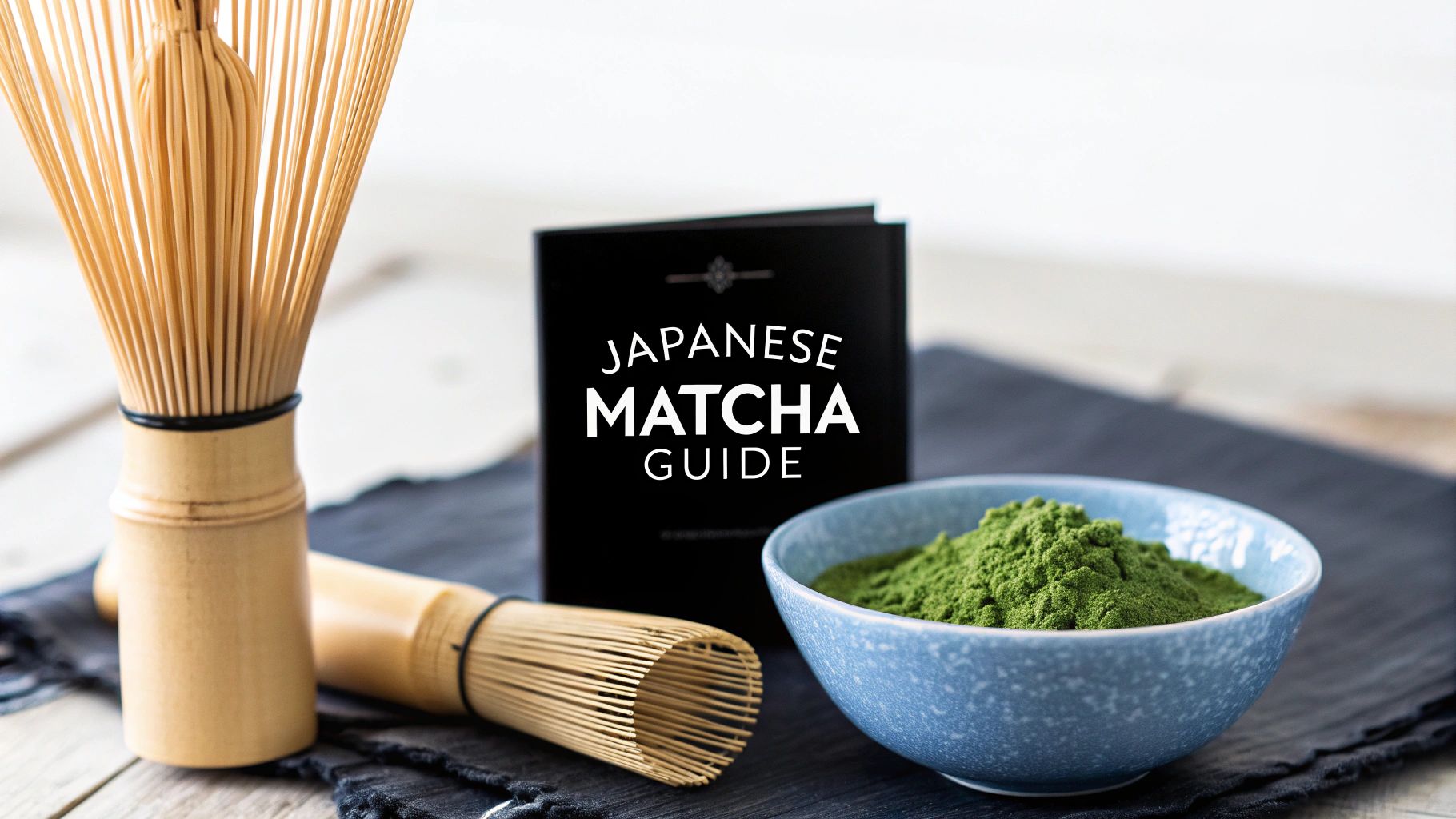When you think of matcha, you’re picturing a uniquely Japanese creation: a vibrant, finely milled powder made from specially cultivated tea leaves. Unlike your standard cuppa, where you just steep the leaves and toss them, with matcha you’re consuming the entire leaf. This is what unlocks its incredibly concentrated flavour and potent health benefits.
This brilliant green powder isn't just a drink; it's the soul of the traditional Japanese tea ceremony and a true star in today's wellness world. Discover how this ancient tradition can elevate your daily ritual and support your modern life.
Uncovering the Essence of Matcha
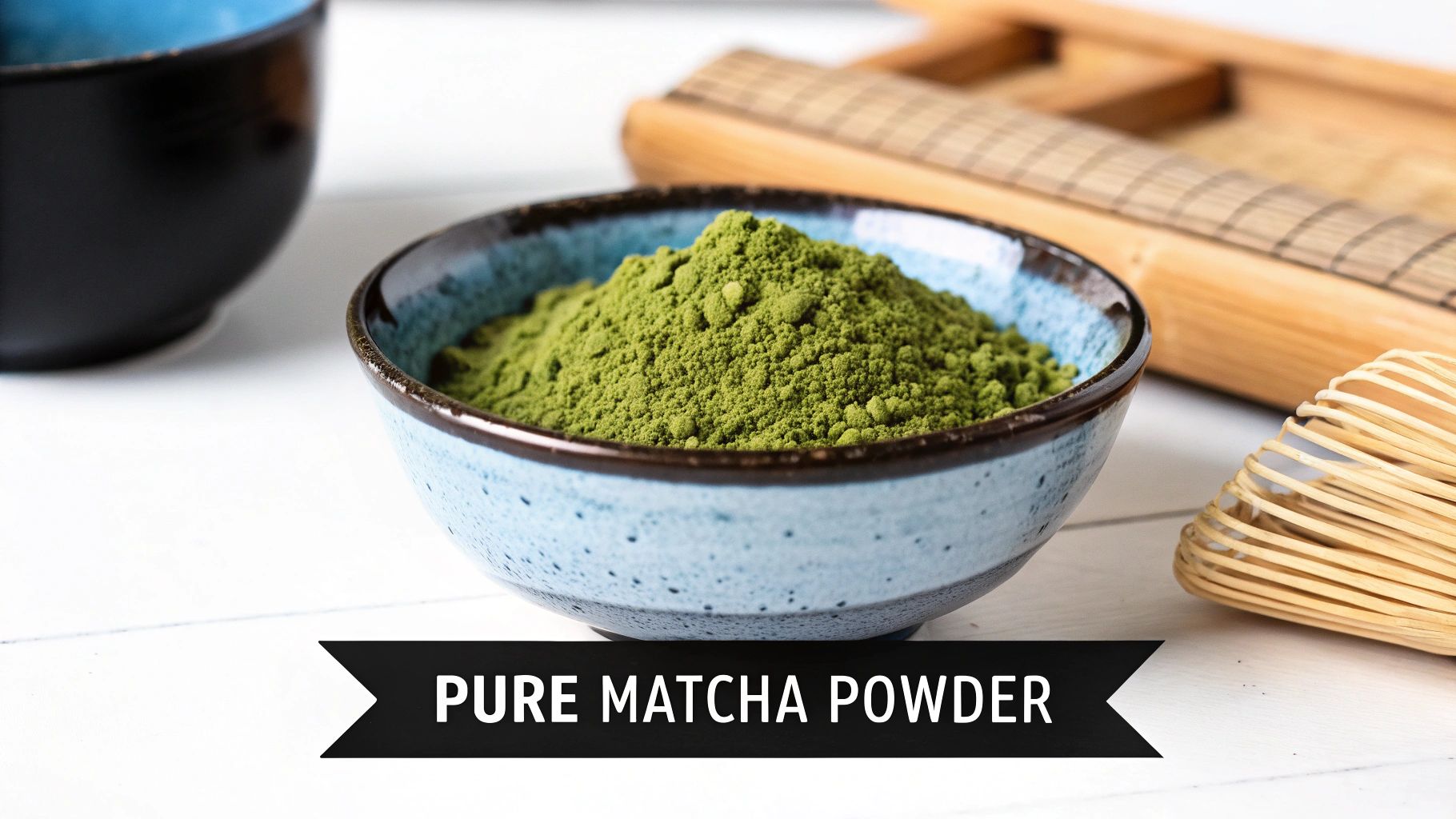
Matcha is so much more than just ground-up green tea. It’s an experience, deeply woven into centuries of Japanese culture and Zen Buddhist practices. The magic begins in the fields, where tea plants are carefully shaded from the sun for about three weeks before they're harvested.
This crucial step is what floods the leaves with chlorophyll and amino acids, especially L-theanine. It’s the secret behind high-quality Japanese matcha green tea powder's stunning emerald colour and its distinctive savoury-sweet flavour, a taste the Japanese call umami. This process also gives matcha its most celebrated effect: a feeling of calm, focused energy, worlds away from the jittery buzz of coffee.
From Ancient Ritual to Modern Wellness
For centuries, Zen monks used matcha as a meditation aid, helping them stay alert and centred during long sessions. Now, its appeal has broken free from the monastery walls. People all over the UK are discovering how it can transform their daily lives, whether as a mindful morning ritual or a powerful pre-workout drink.
This ancient practice fits perfectly into our modern search for well-being. It’s an antioxidant powerhouse, helping to protect your body’s cells and support a healthy metabolism. To get a fuller picture of its history, dive into our guide on what is matcha powder.
Finding Your Perfect Matcha Experience
One of the best things about matcha is just how versatile it is. You can enjoy it in countless ways, making it easy to fit into your routine, whatever your preference.
Matcha isn’t a one-size-fits-all product. It's a spectrum of flavour and function, designed to be adapted to your personal wellness goals and taste preferences.
At Amatsu Matcha, we celebrate this tradition by crafting unique blends to suit different needs:
- Pure: For the purist who cherishes the classic, unadulterated umami flavour of ceremonial-grade matcha.
- Radiance: For those looking to support glowing skin from within with a collagen-infused blend.
- Shrooms: For the biohacker looking to enhance their focus with the added power of adaptogenic mushrooms.
- Strength: For the athlete seeking to boost performance and recovery with added creatine.
Every blend we offer starts with authentic, premium matcha sourced directly from Japan. This ensures each cup not only tastes incredible but also connects you to a rich history while supporting your modern life.
How Premium Matcha Is Crafted
Making authentic Japanese matcha is less like farming and more like an art form. It's a meticulous, time-honoured process where every single step is deliberately designed to cultivate a specific flavour, colour, and feeling. This journey, from the tea fields of Japan to your cup, is precisely what separates ordinary green tea from a truly exceptional matcha experience.
The whole process starts long before a single leaf is picked. About three to four weeks before the harvest, the tea bushes (Camellia sinensis) are carefully covered with dark cloths. This is the crucial shade-growing period.
By cutting off direct sunlight, the farmers trigger a fascinating response in the plant. The leaves start to overproduce chlorophyll in a desperate attempt to capture every last ray of light. This is what gives high-quality matcha its almost electric, vibrant green colour—a clear sign of its purity and potency.
Cultivating Calm and Flavour
But the magic of shade-growing goes much deeper than just the colour. In this low-light environment, the tea leaves also produce higher levels of amino acids, most notably L-theanine. This is the special compound behind matcha's famous ability to create a state of calm, focused alertness—a feeling that’s a world away from the jittery buzz of coffee.
It’s all about a delicate balance. The stress put on the plant actually enriches the leaves, transforming their chemical makeup. This step not only boosts the L-theanine but also develops that deep, savoury umami flavour that is the hallmark of premium matcha. Without this patient shading process, you simply wouldn't have matcha's unique character.
Once the shading period is over, the harvest begins. Only the youngest, most tender leaves from the very top of the plant are hand-picked. These new-growth leaves are the most nutrient-dense and have the sweetest, most delicate flavour, making them perfect for ceremonial-grade powder.
Think of it like a winemaker selecting the finest grapes for a vintage wine. The care taken at this early stage determines the quality of the final product, and for premium matcha, only the absolute best leaves will do.
From Leaf to Tencha
After the harvest, the leaves are rushed to be steamed. This is a critical step, lasting only about 15-20 seconds, but it serves a vital purpose: it stops the leaves from oxidising. Unlike black teas, which are allowed to oxidise to develop their dark colour and malty taste, matcha has to stay fresh and green. Steaming locks in that vibrant colour and preserves all the delicate nutrients.
Next, the steamed leaves are air-dried. Then comes the painstaking task of de-stemming and de-veining them. Every tough, fibrous part of the leaf is meticulously removed until only the pure, soft flesh remains. What you're left with isn't matcha yet; it's a refined material called tencha.
- Shading: Boosts chlorophyll and L-theanine for that bright colour and calm-alert feeling.
- Harvesting: Only the youngest, tenderest leaves are chosen for their superior flavour.
- Steaming: A quick blast of steam halts oxidation, preserving nutrients and the green hue.
- Refining: Stems and veins are removed to create pure, delicate tencha leaves.
This commitment to using only the finest part of the leaf is what gives brands like Amatsu Matcha their silky-smooth texture and gets rid of any bitterness.
The Art of Stone Grinding
The final transformation from tencha to matcha is probably the most iconic part of the whole process. The dried tencha leaves are slowly and carefully ground into an ultra-fine powder using traditional granite stone mills.
This method is incredibly slow. A single stone mill can take up to an hour just to produce around 30 grams of matcha. The slow, deliberate grinding prevents the mills from getting too hot, which would scorch the delicate leaves and destroy their flavour and nutritional goodness. It's a bit like milling fine flour; a gentle touch is needed to preserve the quality.
The result is a powder so fine—just a few microns in size—that it can dissolve seamlessly into water, creating the creamy, frothy texture that defines a perfect bowl of matcha. This final, patient step is the ultimate expression of the care and tradition poured into every single tin.
Choosing Between Ceremonial and Culinary Matcha
When you first dip your toes into the world of Japanese matcha green tea powder, you’ll immediately run into two key terms: ‘Ceremonial’ and ‘Culinary’. It’s a common mistake to think of this as a simple "good vs. bad" comparison, but that couldn't be further from the truth.
Think of them instead as different tools for different jobs. One is a finely crafted instrument for a specific, delicate task, while the other is a versatile workhorse. The real difference lies in how they’re harvested and what they’re meant for. Knowing which to choose is the secret to getting the very best out of your matcha.
The Purity of Ceremonial Grade
Ceremonial grade is the absolute pinnacle of matcha production, representing the finest work of the tea master. It’s made using only the youngest, most tender tea leaves from the very first harvest of the year, known as ichibancha.
These baby leaves are brimming with chlorophyll and L-theanine, which gives the powder its famous, almost electric green colour and a deep, savoury umami flavour. You’ll know it by its silky-smooth texture and naturally sweet taste that has virtually no bitterness.
This is the matcha meant to be enjoyed in its purest form—just whisked with hot water. For that authentic experience, blends like Amatsu's Pure and Radiance are ideal, offering a true taste of Japanese tea ceremony tradition. You can learn more about what makes this grade special in our guide to ceremonial matcha powder.
The Versatility of Culinary Grade
Culinary grade matcha, on the other hand, is sourced from leaves picked in later harvests. Because these leaves are more mature, they produce a powder with a much bolder and slightly more astringent flavour. But this isn’t a drawback; it’s a strength. This robust character is precisely what allows it to hold its own against other ingredients.
If you were to use a delicate ceremonial grade in a latte or a green smoothie, its subtle, nuanced notes would be completely overpowered. Culinary grade, however, has the strength to slice right through the richness of milk or the sweetness of fruit, ensuring that unmistakable matcha flavour always shines through.
Here’s a good analogy: think of it like olive oil. You wouldn't use your most expensive, cold-pressed finishing oil for high-heat frying, would you? You’d grab a more robust, everyday cooking oil. It’s the same logic—you pick the right matcha for the job at hand.
The image below highlights just how much of a nutritional powerhouse high-quality matcha is when compared to standard green tea.
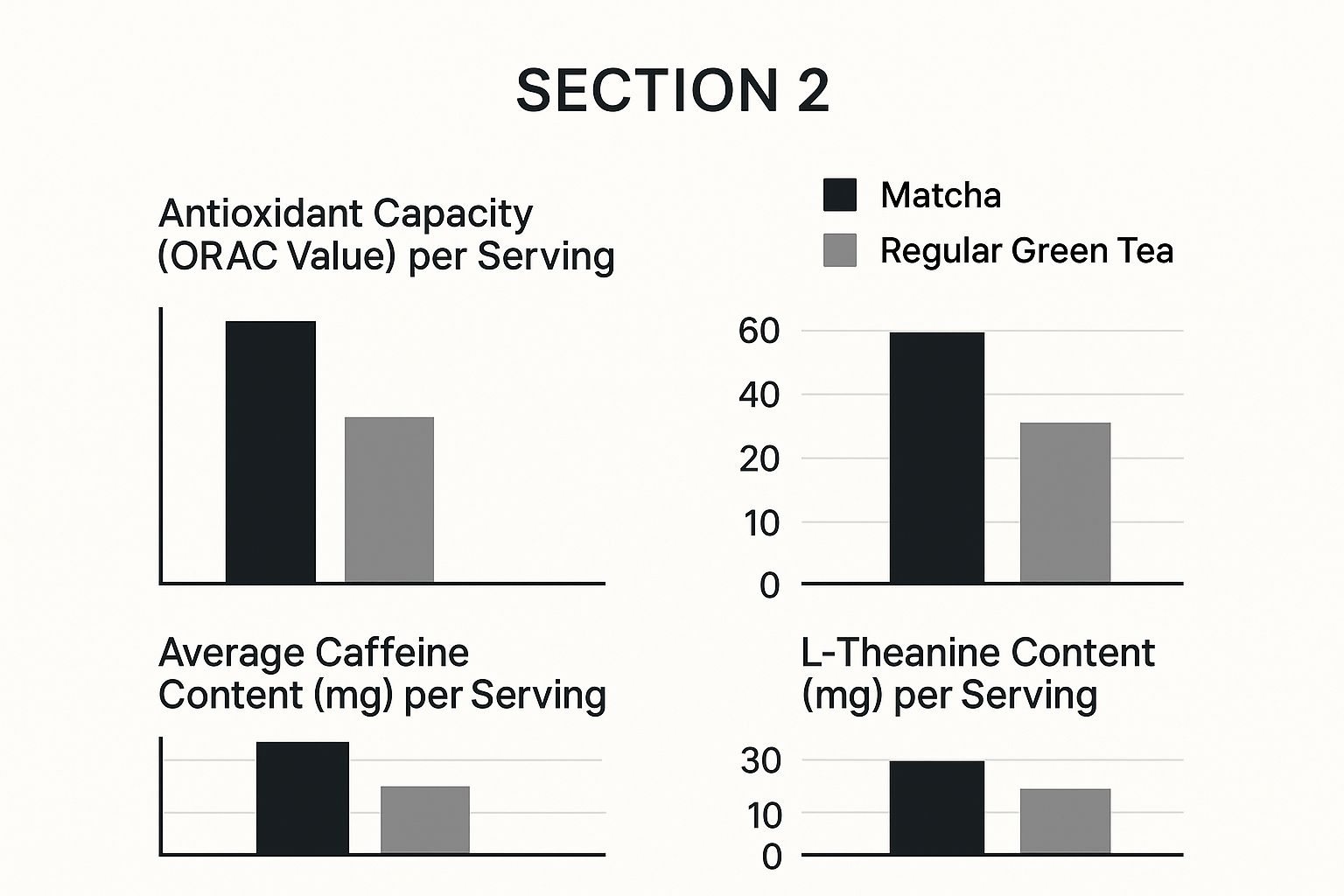
As you can see, matcha packs a far bigger punch of antioxidants, caffeine, and the calming amino acid L-theanine in every single spoonful.
Ceremonial vs Culinary Matcha: A Quick Comparison
To help you decide which is right for you, let's put them head-to-head. This table lays out the main differences at a glance.
| Attribute | Ceremonial Grade Matcha | Culinary Grade Matcha |
|---|---|---|
| Harvest Time | First harvest (youngest leaves) | Second or later harvests (mature leaves) |
| Colour | Vibrant, electric green | Muted, often yellowish-green |
| Flavour Profile | Sweet, delicate, rich in umami | Bold, slightly bitter, robust |
| Texture | Silky and ultra-fine | Coarser, less fine powder |
| Best For | Traditional tea (whisked with water) | Lattes, smoothies, baking, and cooking |
| Price Point | Higher | More affordable |
Ultimately, choosing the right grade comes down to how you plan to enjoy it. Both have a valuable place in a well-stocked pantry.
Choosing Your Perfect Amatsu Blend
Once you grasp the difference, you can see how our different matcha blends are designed to fit into your daily life. While Amatsu's Pure is your classic ceremonial experience for quiet moments, our functional blends are crafted to elevate your recipes.
Picture yourself adding a scoop of Amatsu Strength to a post-workout protein shake or mixing Amatsu Shrooms into your morning smoothie. These blends use a high-quality matcha base, making them perfectly suited for culinary creations that also support your wellness goals—all without sacrificing that delicious matcha taste you love.
The Science-Backed Benefits of Matcha
Beyond its rich history and deep, satisfying flavour, Japanese matcha green tea powder is a true wellness powerhouse. Its growing popularity isn't just a trend; it's firmly rooted in science, offering tangible benefits that can reshape your daily routine. The secret lies in consuming the entire tea leaf, which unlocks a concentrated dose of compounds that support your body and mind in some pretty remarkable ways.
These aren't just abstract concepts. They translate into real-world advantages, from powering through a demanding workday to fuelling your fitness goals. Let's break down the three core pillars of matcha's wellness credentials.
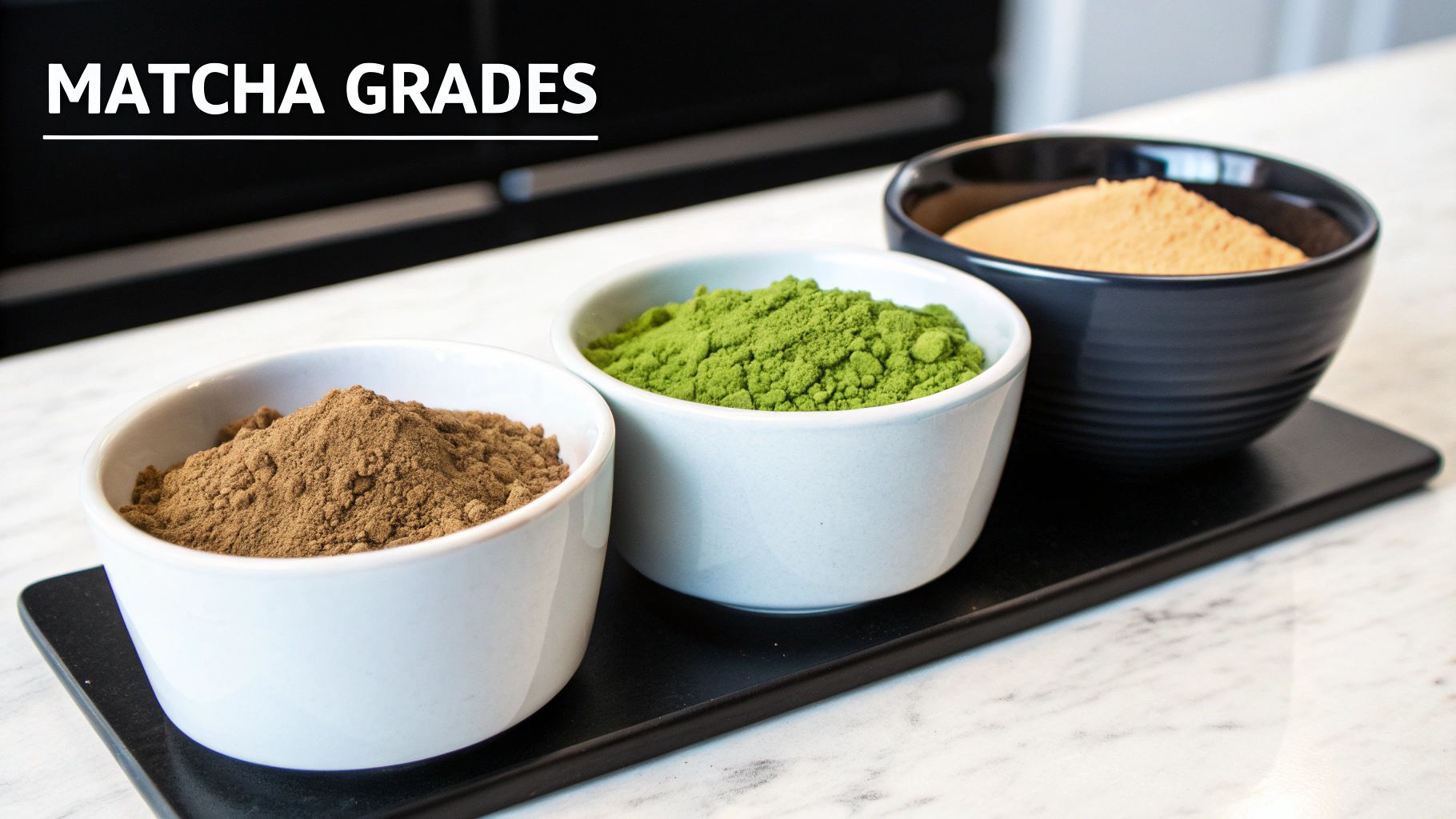
The Synergy of Calm Alertness
Ever felt that jittery, anxious buzz from one too many coffees? Matcha offers a completely different experience. It provides a unique state of calm, focused alertness, all thanks to the magical partnership between caffeine and an amino acid called L-theanine.
While the caffeine provides a gentle lift, L-theanine gets to work promoting relaxation without making you feel drowsy. Think of them as a perfectly balanced duo: caffeine is the accelerator, providing the energy, while L-theanine is the skilled driver, ensuring the journey is smooth, controlled, and free from any sudden crashes. This synergy is fantastic for brain function, enhancing your focus and concentration for hours on end.
This makes matcha the ideal companion for a productive workday or a deep study session, giving you all the mental clarity you need without those unwanted side effects.
A Potent Antioxidant Shield
One of the most celebrated benefits of matcha is its absolutely incredible antioxidant content. These powerful compounds act like personal bodyguards for your cells, helping to neutralise harmful free radicals and protect against oxidative stress—the kind of cellular wear and tear linked to chronic diseases and ageing.
Matcha is particularly rich in a class of antioxidants called catechins, with the most potent of the bunch being Epigallocatechin gallate, or EGCG. Because you're consuming the whole leaf, you get a much higher concentration of these protective compounds than you ever could from just steeping a regular green tea bag.
This dense antioxidant profile supports your overall health, contributing to a strong immune system and promoting a feeling of vitality from the inside out. For a deeper exploration, you can read our comprehensive article on matcha powder's health benefits.
Natural Metabolic Support
Looking for a little boost to your fitness routine? Matcha can be a brilliant ally in maintaining a healthy metabolism. The very same catechins, especially EGCG, that provide all that antioxidant protection have also been shown to support the body's ability to burn calories more efficiently.
This process is known as thermogenesis, which is really just the rate at which your body burns energy. Studies suggest that regularly drinking matcha can give this rate a gentle nudge, making it a fantastic natural supplement to a healthy diet and an active lifestyle.
It’s an excellent choice for a pre-workout drink. You get clean, sustained energy for your session while also supporting your body’s natural fat-burning processes.
Tailoring Benefits to Your Goals
Once you understand these core benefits, you can start using matcha with real intention, targeting your specific wellness needs. This is where specialised blends can truly shine, giving you an extra edge where you want it most.
- For Peak Performance: If you’re focused on physical fitness, a blend like Amatsu's Strength combines premium matcha with creatine to support muscle recovery and energy production, helping you get more from every workout.
- For Enhanced Focus: For those seeking sharper mental clarity, Amatsu's Shrooms infuses matcha with adaptogenic mushrooms like Lion's Mane and Cordyceps, which are celebrated for their cognitive-supporting properties.
- For Inner Glow: To support healthy skin from the inside, Amatsu's Radiance enriches matcha with collagen, promoting elasticity and a vibrant complexion.
By choosing a blend that aligns with your goals, you can elevate the natural benefits of matcha and create a daily ritual that is both deeply enjoyable and purposefully effective.
How to Prepare Your Perfect Cup of Matcha
Making a beautiful cup of Japanese matcha green tea powder at home is much easier than you might think. Forget complicated rituals and expensive gear; with just a few basic tools and a bit of technique, you can whip up a smooth, frothy matcha that rivals your favourite café's. It's all about finding a simple method that works for you.
We'll walk through two fantastic ways to prepare matcha. The first is the classic, mindful approach using a bamboo whisk. The second is a modern, speedy twist with an electric frother, perfect for making creamy lattes. Both are brilliantly simple and give you the power to be your own barista.
The Traditional Whisking Method
This classic technique uses a bamboo whisk, called a chasen, to create a perfectly light and frothy tea. It’s a wonderfully calming process that connects you to centuries of Japanese tea tradition.
- Sift the Matcha: First things first, sift 1-2 teaspoons of matcha powder through a small sieve into your bowl (chawan). This is the secret to a silky-smooth drink, as it breaks up any pesky clumps from the get-go.
- Add Hot Water: Gently pour around 60ml (2 ounces) of hot water over the powder. Aim for a temperature of about 80°C (175°F). If the water is boiling, it will scorch the delicate leaves and make the tea taste bitter.
- Whisk Vigorously: Now for the fun part. Grab your chasen and whisk briskly in a "W" or "M" pattern. Keep this up for about 20-30 seconds until all the powder has dissolved and a lovely, thick foam appears on top.
- Top Up and Enjoy: Add a little more hot water if you like, give it one last gentle stir, and your perfect bowl of traditional matcha is ready to sip.
The key to a rich foam isn't stirring in circles. It's the quick, back-and-forth zigzag motion that pulls air into the tea, creating that signature velvety layer that makes a bowl of matcha so special.
The Modern Frother Method for Lattes
If a creamy matcha latte is more your style, or you’re just short on time, an electric milk frother is an absolute game-changer. This modern shortcut is fast, foolproof, and gives you a consistently smooth finish every time.
Start by sifting your matcha into a mug, just as you would for the traditional method. Add a splash of hot water, then pop in your electric frother and blitz it until you have a smooth, vibrant green paste.
Once you’ve got a lump-free base, pour in your steamed milk of choice—oat, almond, and dairy all work beautifully. Give it one final froth to blend everything into a rich, creamy latte. If you fancy a little sweetness, a drop of maple syrup or honey is a great addition.
For even more detailed instructions and tips, feel free to explore our full guide on how to prepare matcha. With these simple techniques, you’ll be crafting delicious, high-quality matcha at home in no time at all.
How to Choose High-Quality Matcha Powder
With matcha's popularity booming, the market is flooded with options, and it's important to know that not all Japanese matcha green tea powder is created equal. Trying to pick the right one can feel a bit overwhelming, but learning to spot the real deal is simpler than you might think. It’s all about training your senses to recognise the vibrant colour, fine texture, and fresh aroma that define a truly premium product.
When you invest in high-quality matcha, you're not just buying tea; you're investing in a far superior flavour experience and more potent wellness benefits. Think of it like choosing vegetables fresh from the farm instead of grabbing a tin from the back of the cupboard—the difference in taste and vitality is night and day. This guide will walk you through what to look for, so every cup you make is a worthwhile part of your daily ritual.
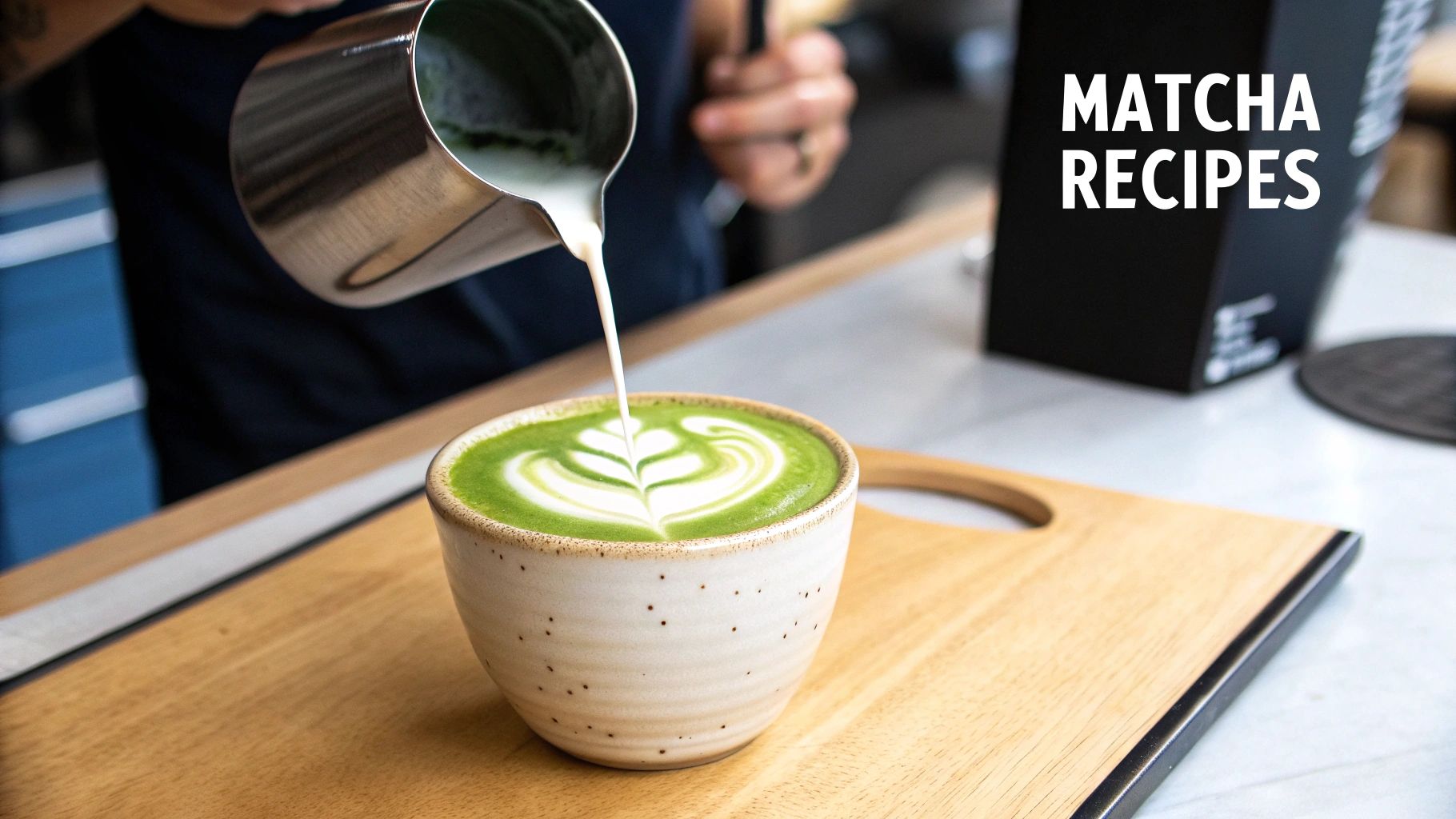
Look for a Vibrant, Electric Green Colour
The first thing you’ll notice is the colour, and it’s one of the biggest giveaways. Exceptional matcha has a brilliant, almost electric green hue. This vivid colour comes from the high chlorophyll levels that develop while the tea plants are shade-grown, and it's a sure sign the leaves were young, fresh, and properly cared for.
If you open a tin and find a dull, yellowish, or brownish powder, that's a red flag. It usually means the matcha was made from older, lower-grade leaves, wasn't stored correctly, or is simply past its best.
Feel for a Silky-Fine Texture
Next, get a feel for the texture. Premium matcha is stone-ground into an incredibly fine powder, with particles just a few microns in size. If you rub a small pinch between your fingers, it should feel silky and smooth, almost like talcum powder or fine eyeshadow.
A gritty or coarse feel suggests it was ground with industrial machines. This process creates too much heat, which can damage the matcha’s delicate flavour and nutrients. That super-fine grind is also crucial for getting the powder to dissolve completely in water, creating that signature creamy, frothy texture without any lumps.
Assess the Aroma and Taste
Your nose is one of your best tools here. High-quality matcha should have a fresh, vegetal, and slightly sweet smell. You might pick up on notes of fresh grass with a deep, savoury umami undertone—a quality that is highly prized by connoisseurs.
A bitter or harsh smell is a definite warning sign. True ceremonial-grade matcha, like Amatsu's Pure blend, should offer a smooth, rich flavour with a subtly sweet finish, not an aggressive bitterness you feel the need to cover up with sugar.
Check for Japanese Origin and Harvest Details
Authenticity is everything. The most revered matcha comes from Japan, especially from regions like Uji, Nishio, and Kagoshima, which are famous for their ideal growing conditions and centuries-old cultivation methods. Always check the packaging for a clear "Product of Japan" label.
It's also worth looking for harvest details. The very best matcha is made from the first harvest (ichibancha) of the year, as these leaves are the most tender, flavourful, and packed with nutrients. Choosing a brand that is transparent about its sourcing, like Amatsu Matcha, gives you confidence that you’re getting a high-quality, authentic product. Finding the right vendor is a crucial first step, and our guide on where to buy matcha tea powder can help you on your search.
Common Questions About Matcha
Dipping your toes into the world of Japanese matcha green tea powder always brings up a few questions. It’s totally normal to be curious, whether it’s about the unique flavour or the caffeine kick. Let’s clear up some of the most common queries so you can start your matcha journey feeling confident and excited for that first sip.
The first thing nearly everyone asks is, "What does it actually taste like?" Forget what you know about other green teas. High-quality matcha is in a league of its own, with a complex flavour that’s rich, smooth, and vegetal. It has a distinctive savoury note—what the Japanese call umami—beautifully balanced by a subtle, natural sweetness. If your matcha is just plain bitter, you’re probably drinking a lower-grade powder.
Another big question is always about the caffeine. How does it stack up against a cup of coffee?
Caffeine Content and Daily Consumption
A standard serving of matcha, which is about one teaspoon, typically contains 30-70mg of caffeine. While that’s often less than your average coffee, the energy boost feels completely different. This is all down to an amazing amino acid called L-theanine. It causes the caffeine to be released slowly into your system, creating a state of calm, sustained alertness—no jitters, and no crash later on.
So, how much is too much? Most people find that 1-3 servings of matcha a day is a great sweet spot. It’s always best to listen to your body, but that amount lets you enjoy all the wellness benefits without going overboard on the caffeine.
The slow-release energy is precisely why so many people love matcha. It supports focus for a productive afternoon just as well as it encourages calm for a meditative morning. It’s a balanced vitality that other caffeinated drinks just don’t offer.
Is Matcha a Global Trend?
Matcha's appeal has well and truly exploded beyond Japan, becoming a cornerstone of wellness routines all over the world. The global matcha tea market was valued at an impressive USD 4.01 billion in 2024 and is only expected to keep growing. Here in the UK, we primarily import high-grade matcha powder from Japan, and you’ll see it everywhere—from traditional tea ceremonies to trendy lattes and even in skincare. You can read more about these market growth insights on grandviewresearch.com.
This global love affair with matcha highlights its unique blend of incredible flavour, rich cultural history, and proven health benefits. It's safe to say this is far more than just a passing trend; it's a timeless ritual that fits perfectly into our busy, modern lives.
Ready to experience the finest ceremonial-grade matcha? Amatsu Matcha offers intentionally crafted blends to support your wellness goals, from pure tradition to functional formulas. Discover your perfect match and elevate your daily ritual today. Shop the full Amatsu Matcha collection.
Read more
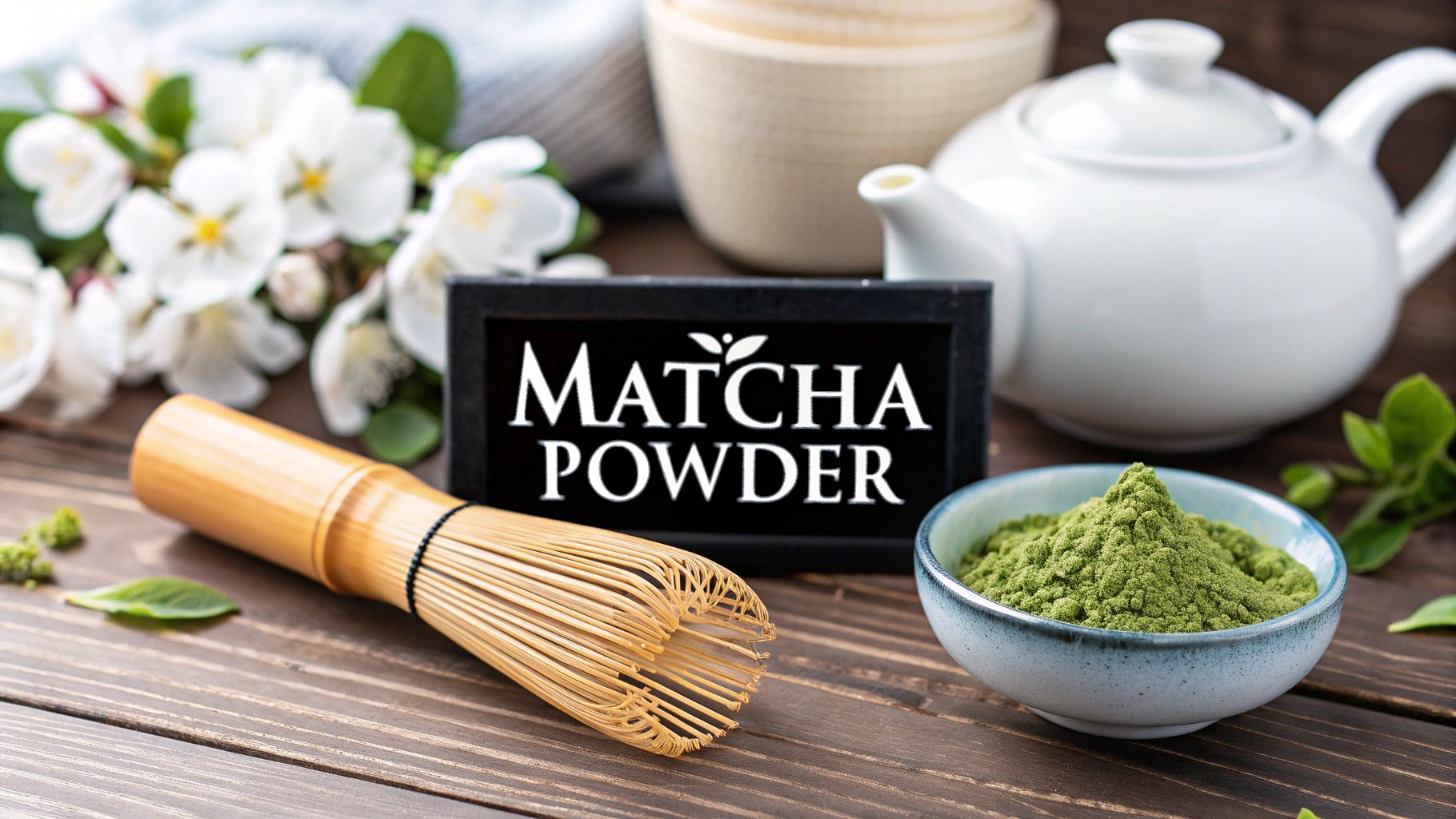
Wondering what is matcha powder? Learn about its origins, health benefits, and how to brew the perfect cup in our detailed guide.
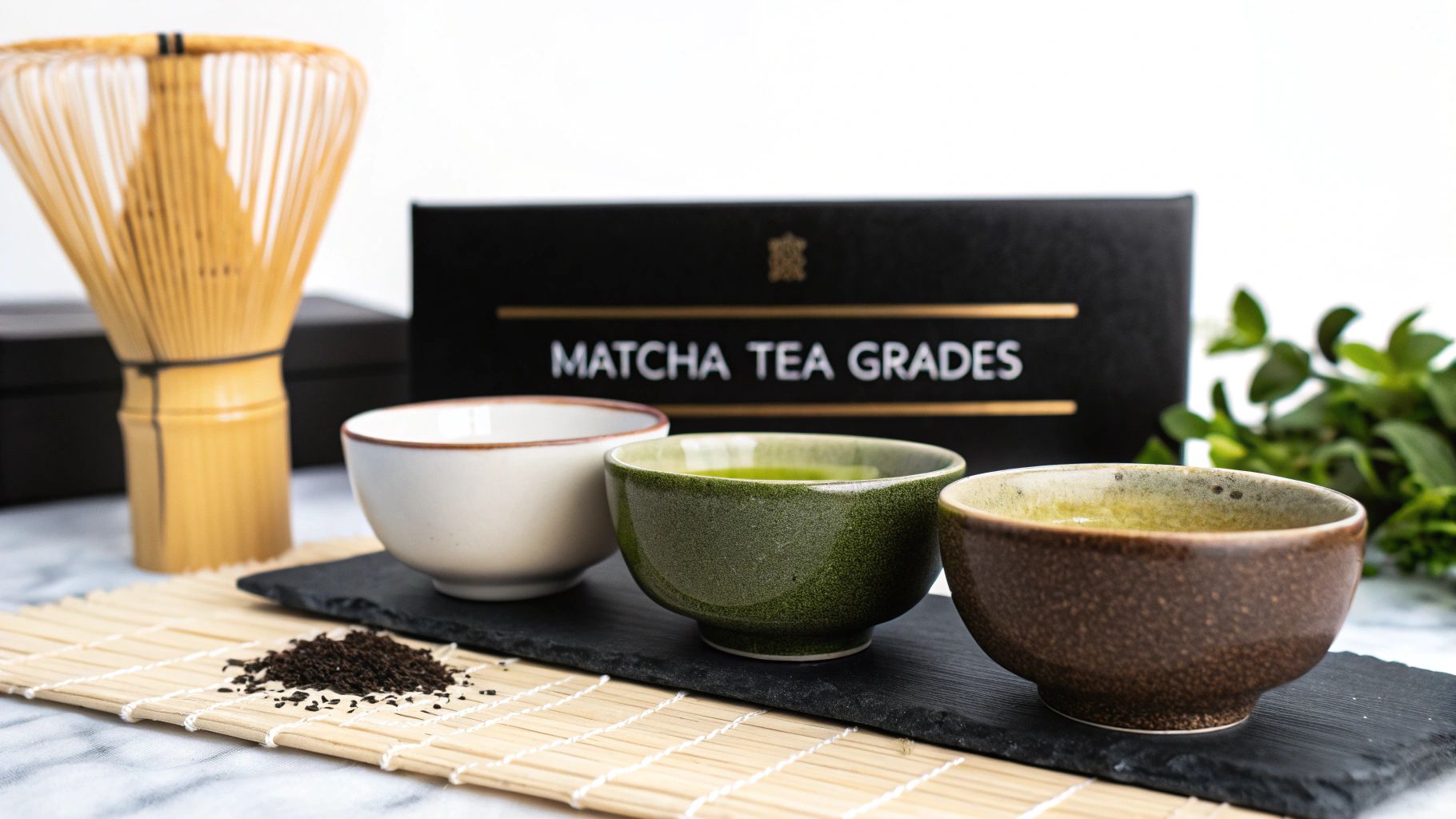
Explore our guide to matcha tea grades, from ceremonial to culinary. Understand the key differences to choose the right matcha for your daily ritual.
